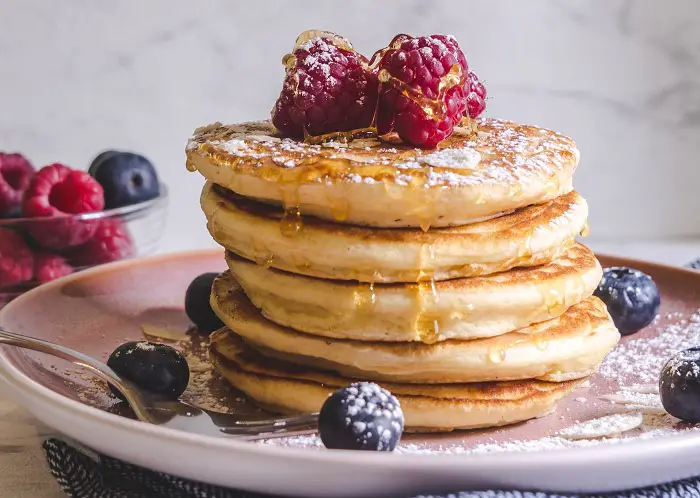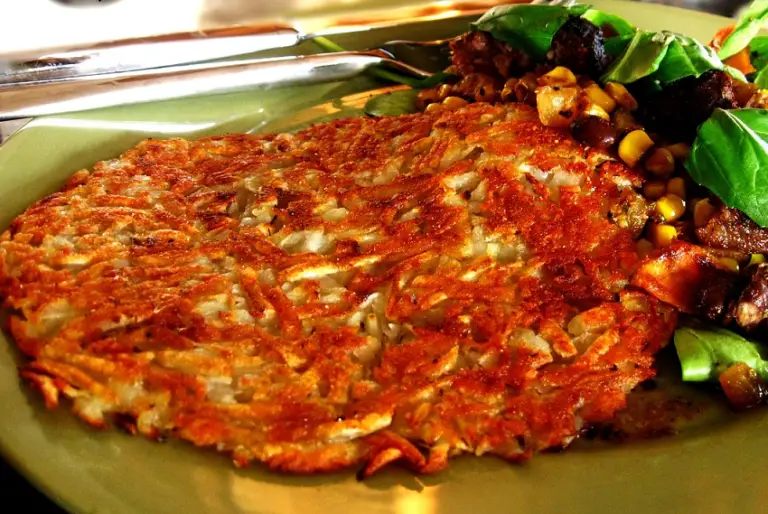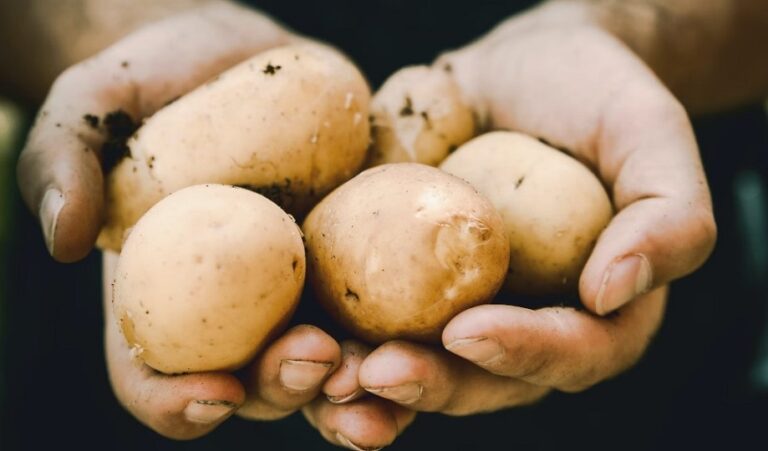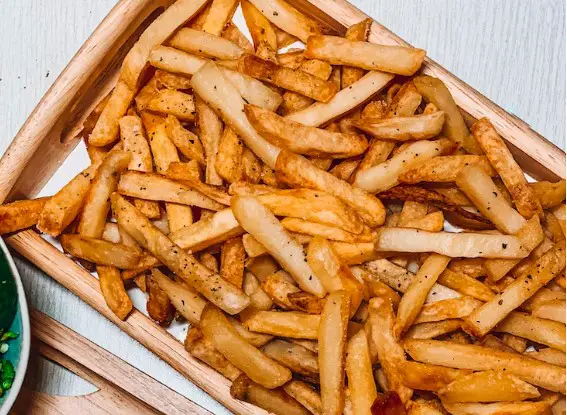A common reason for pancakes remaining raw in the middle is the batter consistency. If your pancake batter is too thick, it creates a density that prevents the inside from cooking thoroughly before the outside turns golden brown or even burns. This uncooked center, which may appear gummy or doughy, isn’t just unappetizing but could ruin your breakfast mood.
Reasons Behind Raw Pancakes and How to Prevent
Alright, let’s dive deeper on why your pancakes might be raw in the middle and how to prevent it:
1. Batter Consistency
The heart of a pancake lies in its batter. Its consistency governs the texture and taste of your final product. If it’s too thick, you’re setting yourself up for an undercooked center. On the other hand, a runny batter might not hold up well and can result in thin, crepe-like pancakes, which might not be what you’re aiming for.
Homemade pancakes give you control. When crafting from scratch, a watchful eye on the liquid-to-dry ratio is vital. If the batter seems more like a dough, it’s time to tweak. Adding liquid incrementally helps in achieving a pourable consistency without making it too runny. Experimentation is the name of the game here. Small adjustments can make big differences. It’s about finding a balance that gives you pancakes that are fluffy inside out.
2. Heat Management
The essence of a perfectly cooked pancake revolves heavily around heat management. The temperature of your pan dictates the cooking speed and overall texture of your pancake. It’s essential to strike a balance. A medium to medium-low heat is usually the sweet spot for pancakes. High heat might give you an enticing golden brown exterior quickly, but it deceives you by leaving a raw, uncooked center. On the flip side, a too-low heat will extend the cooking time unnecessarily, making the pancakes dry out.
Moreover, the consistency in heat matters. Pour the batter only when the pan is sufficiently heated. The transformation of the batter as it cooks provides clues. When bubbles begin to form and pop, it’s a testament to the pancake’s progression in cooking. More bubbles indicate it’s cooking through. It’s not just about cooking the pancake but also about understanding these little signs that the batter gives you. By mastering the art of reading these signs, you can get the timing just right.
3. Pancake Size
There’s a reason why diner pancakes, often large and seemingly perfect, sometimes have a gooey center. The size of a pancake directly impacts its cooking process. The larger the pancake, the more challenging it is to ensure an even cook. When you keep your pancakes to about 3-4 inches across, the heat from the pan can efficiently penetrate through the batter, ensuring a uniformly cooked pancake.
Not only does a smaller size make the cooking process more manageable, but flipping becomes more straightforward too. Anyone who’s tried to flip a large pancake knows the perils of batter spillage or the pancake breaking apart. Smaller sizes are not just about better cooking but also about better handling.
4. Sugar Content
Sugar, while essential for a hint of sweetness, can be a double-edged sword. A high sugar content, either directly added or from sources like fruits or syrups, can cause the pancakes to brown too quickly. This rapid browning can be misleading, making one think the pancake is ready when the inside is still undercooked.
It’s essential to be aware of all sugar sources in your batter. For instance, if a recipe calls for applesauce, it’s introducing both natural and potentially added sugars. Being aware and reducing the overall sugar content can lead to a more balanced and evenly cooked pancake. It ensures that the browning correlates more accurately with the actual cooking of the batter.
5. Mixing the Batter
Mixing seems simple, right? But delve a bit deeper, and there’s a science to it. Over-mixing can be the silent assassin of pancake fluffiness. It activates gluten, leading to pancakes that might seem undercooked or gummy. The mixing process requires a gentle touch.
Once you combine the wet and dry ingredients, mix until they’re just combined. It’s tempting to aim for a super-smooth batter, but those tiny lumps won’t harm your pancakes. In fact, they can contribute to the fluffiness. So, next time you’re whisking away, remember that less is more.
6. When to flip
The flipping of a pancake is almost a rite of passage. Do it too early, and you risk a batter spill. Too late, and it might be overcooked. Waiting for the right moment, when the edges look dry and bubbles are bursting in the middle, is crucial.
Additionally, once flipped, resist the urge to press down. While it might seem like a way to speed up cooking, it’s counterproductive. Pressing can push out the raw batter, leading to an unevenly cooked pancake. It’s about patience and letting the pancake do its thing.
7. Adjustments for Better Cooking
Adaptability is key. Sometimes, even after following a recipe to the letter, the results might not be as expected. This is where your intuition and adaptability come into play. If the batter is too thick, thin it out slightly. If you’re continuously getting undercooked centers, consider increasing your heat slightly or making the pancakes smaller.
Tips for making your Pancakes delectable and Instagram-worthy
Toppings Galore!
- Traditional Toppings: When it comes to pancakes, one can’t skip the classic real maple syrup. Whether you’re team maple or not, having genuine maple syrup is a game-changer.
- Alternative Syrups: If maple isn’t your thing, how about going for something different like agave? Its smoky, earthy taste can give your pancakes a unique twist. Don’t forget the fruit-based syrups either. The balance between sweetness and tartness in berries makes for perfect syrups. Choices like blackberry, boysenberry, blueberry, raspberry, and strawberry are brilliant. Although making them at home is wonderful, there are also some quality store-bought ones that do the trick.
- Creamy Goodness: Elevate your pancake stack with a dollop of whipped cream or the luscious clotted cream. For those who’ve tried clotted cream while in the UK, you’ll know its magic.
- Fruit Enhancements: Mashed up mangos or a sprinkle of powdered sugar can bring a refreshing zest to your pancakes. For a tangy twist, how about some raspberry preserves?
- European Flavors: Embrace the tastes from across the pond. Try a splash of lemon juice and sugar – a favorite of many Brits. Or delve into the Eastern European palate with jam and curd cheese. Flavored quark, especially when enhanced with vanilla extract and a dash of powdered sugar, can make your pancakes truly special.
- Sweet Mix-ins: Make your pancakes stand out with fillings like bananas, chocolate chips (preferably dark chocolate for that rich flavor), and a pinch of cinnamon.
- Chocolate Extravaganza: For the chocoholics out there, products based on Nutella can be a dream come true. Although straight Nutella can be quite sweet, creating a Nutella sauce (by blending it with milk) or a Nutella whipped cream (mixing it with whipping cream) can be heavenly. Pair these with fruits like bananas or strawberries for a taste sensation.
Perfecting the Pancake Process
- Equipment Matters: A heavy-bottom skillet or griddle is ideal. For those of you with an electric griddle, setting it to 325 F and preheating it for about 10 minutes is a good approach. You’ll know it’s ready when a water drop dances on its surface.
- Pan Prep: Before pouring that batter, lightly oil your non-stick pan. A quick swipe with a cold cube of butter between each pancake can work wonders, making the pancakes less prone to burning. However, remember to avoid metal spatulas on non-stick surfaces; they can damage your pan.
- Fluffy Factor: Want to know the secret to ultra-fluffy pancakes? Separate your egg yolks from the whites. Beat the egg whites until they form soft peaks and then fold them gently into the batter at the very end. This little trick aerates the batter and gives your pancakes that extra lift.
- Tactics for Faster Cooking: Covering the pan with a lid can circulate hot air, speeding up the process. But there’s a trade-off: the steam generated might prevent the bottom from browning evenly.
If you’re aiming for picture-perfect pancakes, this might not be the best method. However, if it’s a casual breakfast and you’re famished, this trick can be handy. - Use quality pan: Ensure even heat distribution. Using a quality pan that distributes heat uniformly can significantly cut down cooking time by ensuring every part of the pancake cooks at the same rate.
Pancakes are as much about the experience as they are about taste. With these tips and toppings, your next pancake breakfast is sure to be unforgettable. Enjoy every bite!




